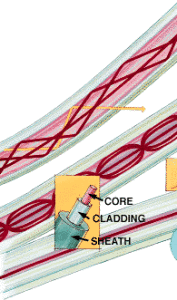Types of optical fibers
An optical fiber (or optical fibre) is a flexible, transparent fiber made by drawing glass (silica) or plastic to a diameter slightly thicker than that of a human hair. Optical fibers are used most often as a means to transmit light between the two ends of the fiber and find wide usage in fiber-optic communications, where they permit transmission over longer distances and at higher bandwidths (data rates) than wire cables. Fibers are used instead of metal wires because signals travel along with lesser amounts of loss; in addition, fibers are also immune to electromagnetic interference, a problem which metal wires suffer from excessively. Fibers are also used for illumination and are wrapped in bundles so that they may be used to carry images, thus allowing viewing in confined spaces, as in the case of a fiberscope. Specially designed fibers are also used for a variety of other applications, some of them being fiber optic sensors and fiber lasers. Types of optical fibers.
Optical fibers typically include a transparent core surrounded by a transparent cladding material with a lower index of refraction. Light is kept in the core by the phenomenon of total internal reflection which causes the fiber to act as a wave guide. Fibers that support many propagation paths or transverse modes are called multi-mode fibers (MMF), while those that support a single mode are called single-mode fibers (SMF). Multi-mode fibers generally have a wider core diameter and are used for short-distance communication links and for applications where high power must be transmitted. Single-mode fibers are used for most communication links longer than 1,000 meters (3,300 ft).

An important aspect of a fiber optic communication is that of extension of the fiber optic cables such that the losses brought about by joining two different cables is kept to a minimum. Joining lengths of optical fiber often proves to be more complex than joining electrical wire or cable and involves the carefully cleaving of the fibers, perfect alignment of the fiber cores and the splicing of these aligned fiber cores. For applications that demand a permanent connection a mechanical splice which holds the ends of the fibers together mechanically could be used or a fusion splice that uses heat to fuse the ends of the fibers together could be used. Temporary or semi-permanent connections are made by means of specialized optical fiber connectors.
The field of applied science and engineering concerned with the design and application of optical fibers is known as fiber optics.
Uses
Communication
Optical fiber can be used as a medium for telecommunication and computer networking because it is flexible and can be bundled as cables. It is especially advantageous for long-distance communications because light propagates through the fiber with little attenuation compared to electrical cables. This allows long distances to be spanned with few repeaters.
Power transmission
Optical fiber can be used to transmit power using a photo voltaic cell to convert the light into electricity. While this method of power transmission is not as efficient as conventional ones, it is especially useful in situations where it is desirable not to have a metallic conductor as in the case of use near MRI machines, which produce strong magnetic fields
Types of optical fibers:
Optical fibers come in two types: Single-mode fibers and Multi-mode fibers.
Single-mode fibers have small cores (about 9 microns in diameter) and transmit infrared laser light.
Multi-mode fibers have larger cores (62.5 microns in diameter) and transmit infrared light from LEDs.
Some optical fibers can be made from plastic. These fibers have a large core (1 mm diameter) and transmit visible red light from LEDs

